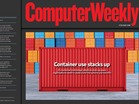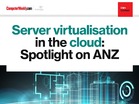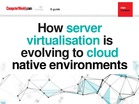Using virtualization to meet demanding graphics app needs
By: Dell View more from Dell >>
Download this next:
Computer Weekly 17 July 2018: How container technology is evolving
By: TechTarget ComputerWeekly.com
Type: Ezine
In this week’s Computer Weekly, as adoption of containers grows rapidly, we look at the choices and potential benefits of the technology, the efforts being made to secure internet of things devices and how the latest Brexit plans will affect the UK tech sector.
Also featured:
- Department for Business, Energy & Industrial Strategy presents supportive response to Lords select committee report on artificial intelligence.
- We talk with Mike Young, CIO at British Gas parent company Centrica, whose CEO recently discussed strategy with Microsoft head Satya Nadella.
In the final part of our buyer’s guide to automation and intelligent systems management, we look at how robotic automation is changing the infrastructure management game, helping IT departments make fewer mistakes and boost their productivity.
These are also closely related to: "Using virtualization to meet demanding graphics app needs"
-
Server Virtualisation in the Cloud: Spotlight on Australia/New Zealand
By: TechTarget ComputerWeekly.com
Type: eGuide
Despite Australia being one of the most mature virtualisation software markets in the world, there is still room for enterprises to take their virtualisation efforts to the next level. More and more of them are now turning to the cloud, running virtual machines on cloud infrastructure and platform services.
In this e-guide, read about what suppliers are doing in a market that is yearning for more efficient ways of running their business, and the role of hyper-converged infrastructure and hybrid IT in supporting the market’s demands.
-
How server virtualisation is evolving to cloud native environments
By: TechTarget ComputerWeekly.com
Type: eGuide
Server virtualisation has given businesses the ability to abstract applications and the operating system from the underlying hardware. For years organisations have used virtualisation to gain greater levels of utilisation from their hardware investments, where one big server is divided into multiple VMs (virtual machines), each of which can be configured to run a workload, comprising an operating system and a software environment.
Businesses can deploy appliances, known as hyper-converged systems, that combine CPUs, storage and virtual server environment, all in one box. These tend to be horizontally scalable, enabling IT departments to grow their virtual server environment simply by adding another appliance. The management software in hyper-converged systems takes care of distributing workloads to maximise the greater level of computational power and storage available.
Today, thanks to the advent of infrastructure as a service, organisations can choose to run their VMs locally, on premise, or in a public cloud using IaaS (infrastructure as a service) from any of the major cloud providers.
Among the biggest problem areas in server virtualisation is the idea of VM sprawl. Since, they are not physical servers, VMs can easily be created. Often, however, they are not removed if they are no longer required. On-premise, this may not create such a big issue, since a dormant VM does not really consume resources like CPU, memory and storage. But if they are left to run indefinitely in the background, they will continue to consume valuable IT resources. In a cloud environment, businesses can incur huge fees if they fail to administer their virtual servers properly.
While server virtualisation is a well-established method to reduce IT costs by consolidating on-premise servers and running appropriate workloads in the public cloud, a new IT architecture is now emerging. Rather than virtualise existing software environments, new applications are increasingly being developed to run natively in the cloud. This approach departs from the horizontally integrated software stack that applications have traditionally been built upon. Instead, the application code is divided into functional units known as microservices, each of which runs in a lightweight virtual environment known as a container. The code within the container, can be an internally developed microservice, or one from an external provider. A cloud native architecture uses containers to run a set of microservices in order to perform a required function programmatically.
Find more content like what you just read:
-
IT Project: Virtualisation
By: TechTarget ComputerWeekly.com
Type: eGuide
Virtualisation, in all its forms, has dramatically changed the way enterprise datacentres are operated, managed and built over the course of the past decade or so.
-
VMworld Europe 2016: What to expect
By: TechTarget ComputerWeekly.com
Type: Essential Guide
VMworld Europe 2016 hits Barcelona in October, with VMware expected to announce new and refreshed products and services in support of its end-user computing and cloud strategy. In this e-guide, you'll find case studies featuring last year's winners, along with articles covering the technologies VMware looks set to champion at this year's event.
-
Desktop Virtualisation: The Essential Guide
By: TechTarget ComputerWeekly.com
Type: Editorial Resource Guide
Desktop virtualisation, or virtual desktop infrastructure, has come of age, partly thanks to shifts in workplace practices. Employees are increasingly working remotely and need full access to corporate systems. It is often inconvenient to use the corporate laptop but the user still needs access to the systems offsite.
-
Focus: on premise virtualisation
By: TechTarget ComputerWeekly.com
Type: eGuide
We take a closer a look at the virtualisation of on-premise resources, and find out why it remains such an important process for enterprise datacentre owners to go through.
-
Event recap: VMworld 2018 Europe
By: TechTarget ComputerWeekly.com
Type: eGuide
It is the 20th anniversary year for VMware and at the VMware European conference in Barcelona, the company famous for its hypervisor, showcased how it had changed the face of IT, and where it was heading next.
-
VMworld 2019 Europe: Where next for VMware?
By: TechTarget ComputerWeekly.com
Type: eGuide
In this e-guide, check out ourround-up of some of the biggest announcements VMware made at this year's VMworld US 2019 conference, as part of a countdown towards its European conference in November 2019.
-
Server virtualisation rules the datacentre roost
By: TechTarget ComputerWeekly.com
Type: eGuide
In this e-guide, we take a closer look at server virtualization in the enterprise, and find out why it remains such an important process for datacentre operators to go through.
-
Computer Weekly – 16 April 2024: VMware users hit by licence hikes after Broadcom takeover
By: TechTarget ComputerWeekly.com
Type: Ezine
In this week's Computer Weekly, VMware users are facing licence fee increases after the acquisition by Broadcom, with education bodies worst hit – we talk to unhappy customers. Read the issue now.
-
Top 10 ASEAN IT stories of 2022
By: TechTarget ComputerWeekly.com
Type: eGuide
Despite challenges, those in ASEAN have taken things in stride as they press on with digital transformation, whether it is empowering citizen developers or building cloud-native applications. Here are Computer Weekly's top 10 ASEAN IT stories of 2022.
-
VMware Licensing Changes by Broadcom – Details, Implications, and Recommendations
By: Park Place
Type: White Paper
Broadcom's acquisition of VMware changes VMware's licensing model. This article examines the details, implications, and recommendations for customers, including the removal of perpetual licenses, a simplified product portfolio, and more. Browse the article to understand how these changes impact your organization and explore support options.
-
Case Study: A Retailer’s Network-security Journey
By: VMware, Inc.
Type: Case Study
A large sporting goods retailer set two goals: to enhance its application performance monitoring (APM) capabilities and to strengthen its network security. Download this case study to discover how the retailer achieved those goals with help from VMware and Hughes Managed Services.
-
VMworld 2017 recap: Adapting legacy IT
By: TechTarget ComputerWeekly.com
Type: Ezine
In this week's Computer Weekly, experts at VMworld 2017 discussed how to adapt legacy IT to make the most of modern technology – we listened in. Artificial intelligence is touted as an aid to decision-making, but it needs to be handled with care. And we learn how Wales has become a hotspot for cyber security innovation. Read the issue now.


